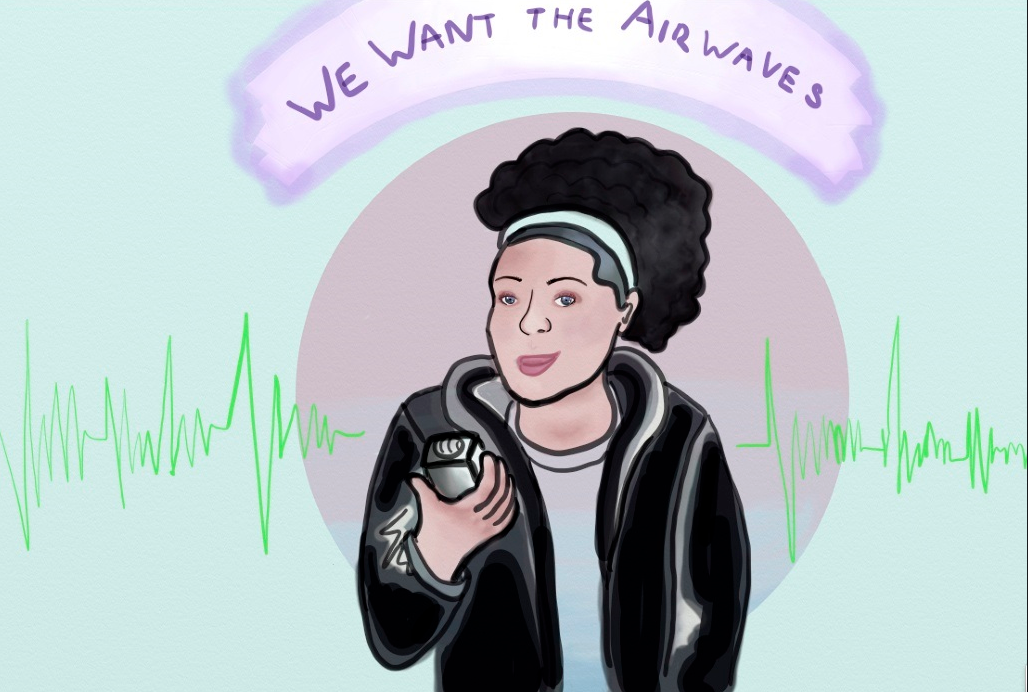 We Want the Airwaves logo (Artwork by Myles L.)
We Want the Airwaves logo (Artwork by Myles L.)
Queer and Trans Artists of Color: A Collection of Interviews Unlike Any Other
By Luna Merbruja
I met Nia King when she asked to interview me for her podcast, We Want the Airwaves, a podcast highlighting queer and trans artists of color and the work they are doing. When figuring out a quiet place to meet, I suggested UC Santa Cruz’s library, which was the university I was attending at the time, and it happened to be Finals Week. We took over an empty study room (guerrilla style, fuck yeah!) for an hour before we were kicked out by some white dude (go figure, and you can also hear it on the podcast).
When Nia sent me the draft of our interview, I realized how much knowledge I had to share on self-care, sex work, and harm reduction, and how I wasn’t talking about these things enough. That’s how I know Nia is an incredible interviewer - she knows how to ask questions that give space for brilliant answers.
When I found out she was creating a book out of the podcast transcriptions, I was ecstatic to hold more stories and see what other wisdom she pulled out of QTPOC artists. I was so excited that I had to interview her about her book, Queer and Trans Artists of Color: Stories of Some of Our Lives, which you can pre-order here. If you’re in the San Francisco Bay Area, there’s going to be a launch party at the Show & Tell Concept Shop on September 26th from 7 to 9 PM that will include performances by Virgie Tovar, Magnoliah Black, and Ryka Aoki - all artists who are featured in the book.
Luna Merbruja: Nia King, you and your co-editors Terra Mikalson and Jessica Glennon-Zukoff have compiled 16 interviews with queer and trans artists of color into one book. This is an incredible archive of stories and experience that hasn’t been archived before. What made you decide to create a book instead of leaving the transcriptions of the interviews up on your website?
Nia King: Thank you for your kind words about the book! I wanted to make a book because it didn’t seem like a lot of people were really listening to the podcast or reading the transcripts online. I also thought making a book would help make the content accessible to new and hopefully bigger audiences, people who aren’t internet savvy or don’t have internet access at all, like folks in prison.
I wrote the book largely because I wanted my parents to understand what I’ve been doing with my life for the two years that I’ve been unemployed, and why this work matters to me. They don’t really listen to podcasts.
Luna: So here’s one of the hottest questions I’m sure is on every artist’s mind - especially queer and trans artists of color - how do you make money?
Nia: Very, very slowly. I don’t think making a living of your art is something you do overnight; it takes a while to build contacts and find people that are willing to pay you for your work, willing to take a chance on you if you’re not well-known. In the meantime, having a day job really helps.
I assumed that many of the artists featured in the book were in a place in their careers where they could live off their art, but the closest I think anyone’s come to that is Janet Mock, a writer, who was at one point living off of her advance for Redefining Realness. Ryka Aoki probably comes closest to living off of her art after Janet. She is a writer and teaches writing for a living. Most of the artists in this book are not making a living off of their art. Some do sex work, some wait tables, one works at the post office.
Luna: It seems like a lot of artists have day or night jobs to pay the rent, and then maybe do art to fulfill their passions. As a TWOC artist, I didn’t have access to performance art coaching or writing classes that centered my experiences. How were other artists able to hone their crafts and skills?
Nia: Some folks learned their craft in school, but most of them really developed their art and skills through mentors outside of school, by finding someone that believed in them, saw their potential, and could help connect them with resources, or knew someone who could. I think a lot artists learn by doing. It’s not necessarily about formal training. Some of the artists in the book are college dropouts, some of them have PhDs. Ryka Aoki and Janet Mock both happen to have Master’s degrees. They both mention in their interviews how having those credentials helped them be taken seriously in their respective fields.
Luna: It looks like there’s a mixture of schooling and community-based practice and mentorship. I think mentorships are most effective when the person mentoring you shares similar struggles - such as ethnicity, gender, socio-economic upbringing, etc. Your book covers a range of intersecting identities, which is great for readers who are looking for real life examples of themselves. Can you describe the process of how you chose your guests?
Nia: Virgie Tovar was my first interview. I had the privilege of sharing a stage with her at La Peña Cultural Center in Berkeley as part of an event called Radar Presents East Baydar. I think afterwards I tweeted at her, told her I liked her work, and we had coffee and hit it off.
I told her I was thinking about starting a podcast, asked her if she wanted to be on it, and she said yes. At first I interviewed people I already knew or had shared connections with. Micia Mosely was my boss. Magnoliah Black was someone I had heard speak at an event in San Jose called A Fatty Affair and was really impressed by.
Eventually I started getting a little less timid and starting cold calling people. I was really surprised by how open they were to being interviewed by me, because I didn’t think anyone really knew who I was. I think having a website made me seem a little more legit. Having a semi-professional web presence helped me a lot actually.
Luna: I think artists, especially those underrepresented, love to feel like someone has an interest in their work and appreciate you reaching out to interview them about their art.
Nia: For sure. A lot of these folks are sort of under-recognized too. Eventually bigger and bigger names were willing to talk to me and people starting hearing my name in community so I didn’t have to “cold call” them. Now people are asking me to be on the podcast!
Luna: That’s awesome! I’m really glad you’re getting folks interested in being interviewed. As you mentioned, part of your work was creating a website to have a more professional presence for potential interviewees. What are some of the logistics behind putting together a book of interviews?
Nia: Oh, lordy. Transcribing the interviews, then getting them to all be in the same format, because they were all transcribed by different people. Then making sure it still makes sense. Then having the artist look at it and make sure it’s still factually accurate. Raising money to pay the artists, my co-editors, and the graphic designer. Making Indiegogo perks. Shipping Indiegogo perks. Working with the graphic designer on the cover design. Editing, editing, editing, and more editing. Remembering to thank everybody. Making sure everyone gets paid.
Right now, I’m planning a launch party, which will take place at Show and Tell Concept Shop in downtown Oakland on September 26th from 7 to 9 PM and feature performances by Magnoliah Black, Ryka Aoki and Virgie Tovar.
Luna: I have a few questions for the co-editors who helped make this book flow so smoothly, Jessica Glennon-Zukoff and Terra Mikalson. What made you want to be a part of this project?
Jessica: Well, it’s no secret that I’m a fan of Nia - she’s a friend as well as an artist-zinester-writer-producer I truly admire. But even beyond the opportunity to work with her, I wanted to be part of this book project because these are stories that need to be heard and that by and large are not being presented together like this to a broad audience. Nia kind of wryly remarked the other day that the fact that the title of the book (Queer and Trans Artists of Color) is so straightforward speaks to how there aren’t really other books like this out there right now.
Terra: By the time Nia asked me to be a part of this project, I had already become a huge fan of the We Want the Airwaves podcast — its guests had become my favorite company on my daily commutes to my day job. I wanted to be a part of ensuring that these amazing artists and their ideas reached as many people as possible. Not everyone listens to podcasts; the book will reach a different audience.
Luna: Were there any interviews that had an especially strong impact on you?
Jessica: The interviews with Ryka Aoki, you [Lovemme Corazon], Virgie Tovar, and Fabian Romero are ones that I feel offer some especially concrete wisdom.
Luna: After working on this book for a year, what have you taken away from this editing experience?
Terra: I teach academic English grammar to high school students at my tutoring job, so with this project, I had to be very careful about my mindset. I had to learn to balance the clarity that can be achieved through these somewhat rigid grammatical formulas with a desire to maintain the tone and voice of the artists. I had to make sure that my particular dialect of English and academic background didn’t take over these artists’ words. Jessica, Nia, and I had many discussions about the political significance of different punctuation marks. It sounds extreme, but we did! Every edit was made with deliberation and intention. My prime directive was always, “Make the ideas shine.”
Luna: Last question for Nia. What are some memorable stories you’ve heard?
Nia: The story about how Yosimar Reyes almost got deported on the way to perform for Carlos Santana and Harry Belafonte is a memorable story. I think Nick Mwaluko’s story about how he got away with having gay sex in Africa IN PUBLIC is pretty memorable. I’m curious which ones you thought were memorable!
[All of the unedited transcriptions are still available for folks to read here]
Luna: Is there anything else you’d like to share about your book? Final words? Great collective QTPOC wisdom?
Nia: I’m just excited to help bring exposure to a lot of amazing artists who have kind of been slept on because they are not straight, not white, not cis, etc. I hope this book helps to give them their proper place in history.
This is one of many articles featured as apart of our Millennial Culture Creators series
Luna Merbruja
A bruja creature writing and residing in Central California.
Catch up with me @LunaMerbruja.

